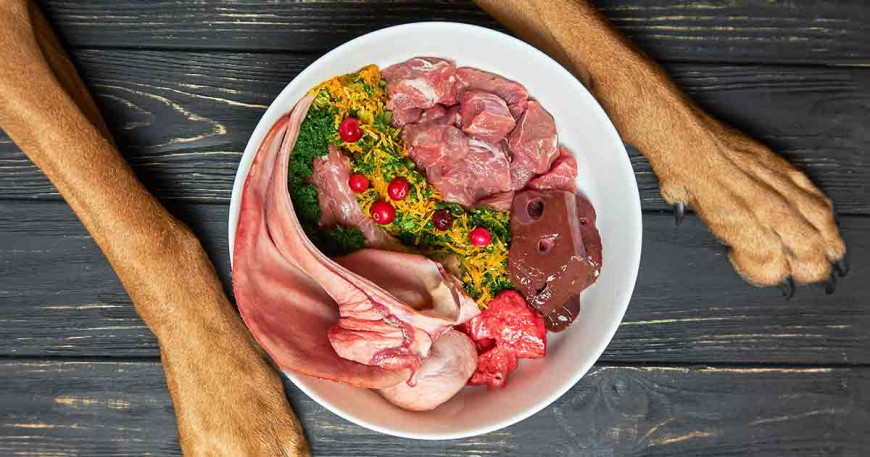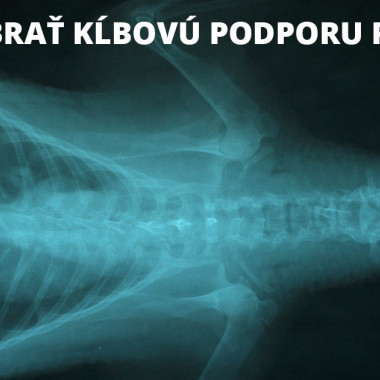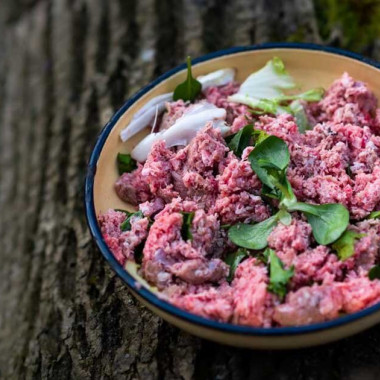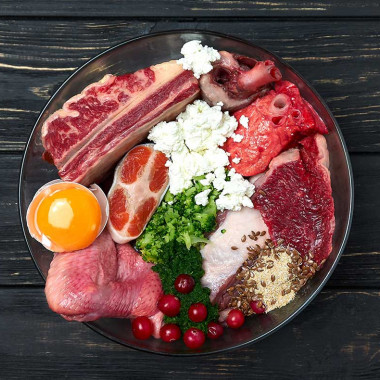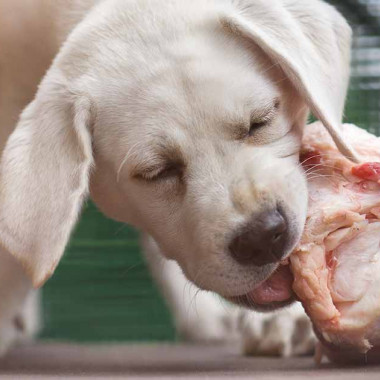The word BARF originates from the acronym of the English words Bones And Raw Food or Biologically Appropriate Raw Food. BARF is the most natural and, to date, unmatched method of feeding dogs. The basis of the BARF diet consists of raw meat and raw bones. Since ancient times, a dog's stomach has contained very strong gastric acids that can easily handle raw meat and bones. Dogs even possess the so-called needle reflex, which protects their stomach and intestines from injury by sharp bone fragments. Therefore, there's no need to fear feeding raw bones. Additionally, by gnawing on them, dogs naturally clean their teeth, resulting in less tartar formation.
Can BARF Be Harmful?
Some might think that today's dogs' digestive systems must have adapted to commercial kibble and that raw meat or bone fragments could harm them during consumption. However, the opposite is true. Kibble has been on the market for just over 100 years, which is too short a time for an animal's digestive tract, like that of a dog, to adapt to the point of being unable to process its natural food. While many dogs don't have problems with kibble, it's not the ideal food. Just read the ingredients carefully, and you'll immediately realize that even the best kibble can't compare to fresh food—not to mention the preservatives and flavor enhancers that kibble contains, as well as grains, which are common allergens for dogs.
Salmonellosis and BARF: Truth or Myth?
Feeding raw meat doesn't automatically mean a salmonellosis infection. If the dog is healthy and strong, it can digest Salmonella bacteria. However, if these bacteria multiply excessively in the dog's intestine, they cause an infectious disease—salmonellosis. Dogs fed with BARF naturally have a stronger immune system and a more acidic (and thus healthier) stomach environment than dogs fed with kibble, which means they more effectively kill pathogenic microorganisms, including Salmonella bacteria. Therefore, it doesn't harm a healthy dog to consume remnants of an animal in the wild. However, if you want to prevent salmonellosis in your dog, always buy meat from a trusted supplier and store the food properly. You can find high-quality and inspected meat for your dog in our e-shop. If you want to learn more about the symptoms, diagnosis, and treatment of salmonella in dogs, read our article: Salmonella in Dogs: Modes of Infection, Symptoms, Diagnosis, and Treatment.
BARF is a Return to Nature
Dogs were domesticated approximately 15,000 years ago. Their ancestors were wolves, who lived off their prey. They ate the internal organs, muscle meat, and bones, and often supplemented their diet with herbs or forest fruits. Their digestive tract was adapted to efficiently digest each of these ingredients. Today's dogs have a similarly adapted digestive system. Therefore, within the BARF diet, you can enrich your pet's feeding portion not only with raw meat, offal, and bones but also with herbs, fruits, vegetables, nuts, dairy products, plant and animal oils, and other supplements if needed.
Health Benefits of the BARF Diet
With the BARF diet, it's possible to restore a dog's lost vitality and zest for life, improve coat quality and joint health, optimize body weight, prevent various allergies and diseases, and significantly improve deteriorated health conditions. Meat, bones, as well as fruits and vegetables, are the best-utilized sources of vitamins, minerals, and trace elements for dogs in their natural form. Feeding with raw food is very simple and suitable for every dog, regardless of breed, size, age, or pregnancy. There are many more health benefits, including:
Healthier skin, coat, and joints
Healthy and beautiful teeth without tartar
More energy, increased vitality, and zest for life
Balanced body proportions—optimization of body weight
A stronger and healthier immune system
Prevention of allergic reactions and diseases
More efficient digestion—less flatulence and fewer excrements compared to other types of dog food
Nowadays, people have a wide range of options on how to feed their dogs. It can sometimes be really difficult to decide. Therefore, if this method of feeding has caught your interest, read other articles where you'll find advice and tips. We definitely recommend starting with the articles below.
How to Feed with BARF and What to Watch Out For
Besides what's recommended, it's important to mention what is not recommended when BARFing and what to watch out for. It's very important to know which foods are unsuitable for dogs. These include commonly known items like chocolate, avocado, and onions. Cooked or baked bones are also dangerous for dogs. They are hard to digest, much harder than raw bones, and when chewed, they splinter into sharp pieces that could injure the dog's digestive tract. Therefore, it's safe to give dogs only raw bones. Also, too many bones can cause constipation in dogs. You can read more about unsuitable foods for dogs in our article: Foods Unsuitable for Dogs.
Suitable Foods and Balanced Feeding Portions for BARFing
A balanced feeding portion and the volume of individual items in the BARF diet should be composed with regard to the dog's needs, body proportions, breed, age, and health condition. By correctly composing the feeding portion, we can significantly improve the life of a senior dog or even cure health problems. Depending on the above, the feeding portion should consist of approximately:
Meat and Offal (50-70%) - Of this amount, approximately 50% should be muscle meat, 40% internal muscle tissue (heart, unwashed green tripe), and about 10-15% offal (liver, kidneys, etc.).
Bones and Cartilage (20%) - It's safe to give dogs only raw bones. They are the main source of phosphorus and calcium in the BARF diet. They also contain minerals, vitamins, and iron. Bones and cartilage are used in combination with fibrous side dishes in BARF feeding to regulate stool density. If bones make up more than 20% of the feeding portion, we can cause constipation in the dog.
10% Fibrous Side Dish - This consists of suitable vegetables and fruits, eggs, dairy products, or a small amount of grains. Vegetables and fruits provide the dog with necessary fiber, vitamins, minerals, omega-3 essential fatty acids, and enzymes.
Learn more about how to create a BARF meal plan in our article: How to Create a BARF Meal Plan.
